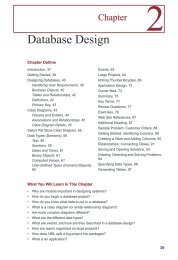Database Management Systems Appendix: Projects - Jerry Post
Database Management Systems Appendix: Projects - Jerry Post
Database Management Systems Appendix: Projects - Jerry Post
- No tags were found...
Create successful ePaper yourself
Turn your PDF publications into a flip-book with our unique Google optimized e-Paper software.
Sensor ActivationSensor DateTime BadgeID DirectionFigure 5Figure 5 would never be printedin real life, because there would be toomuch data. It represents the sensoractivation data collected by every sensorin the company. The sensors record thedate and time as well as the person goingthrough the door. The direction of travelis also noted. The sensors are relativelyaccurate and can even handle two peopleentering a door at approximately thesame time. If one person enters a roomand immediately turns around, it wouldbe recorded as an entrance followed by an exit—adding two rows of data. With almost20,000 employees on the main campus, a dozen buildings with several floors of offices andlabs, the sensors collect a large amount of data every day.In general, security personnel want the ability to track the movements of employeesTracking LogEmployeeOffice Phone Cell PhoneStart - EndTime-In Location (Building/Room) Time-Out DoorFigure 6throughout the day. In mostcases, the report shown inFigure 6 is displayed only whensecurity personnel becomesuspicious of an employee. Thereport is slightly tricky to createwhen rooms have several doors.Also, remember that sometimessensors fail, so the system mightnot record a person entering orleaving a room. Ultimately,managers would like to see agraphical display of this data—based on an electronic map of the campus. But, for now,they will be happy with this report that shows all of the activities of a suspicious employee.Exercises1. Create the feasibility study (initial proposal).2. Create a list of all of the forms and reports that the company might use.3. Create a normalized list of tables for each form and report.4. Create an integrated list of normalized tables for the entire application. Draw thecorresponding class diagram.5. Create the basic tables in a DBMS along with all necessary relationships andintegrity constraints. Enter sample data into the tables to test your design.6. Evaluate the normalized tables and estimate the size of the database—both currentsize and estimated size in 3 years.7. List the initial security conditions for the data tables. Create a list of user groupsand identify their basic access needs.8. Design the overall structure of the application. Outline the overall structure and theprimary forms. Select a design scheme, including layouts, effects, and colors.9. Build three initial input forms.10. Build three initial reports.11. Improve the forms and reports to make them easier to use.12. Test your forms and reports with sample users.14







